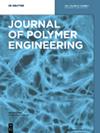Synthesis and properties of reed-based polyurethane (PU) coating
IF 1.7
4区 工程技术
Q4 POLYMER SCIENCE
引用次数: 0
Abstract
The reuse of agricultural waste and the development of bio-based materials are the main strategies for solving the global energy crisis and environmental problems. Agricultural waste reeds containing natural nano-silica (SiO芦苇基聚氨酯(PU)涂层的合成与性能
农业废弃物的再利用和生物基材料的开发是解决全球能源危机和环境问题的主要战略。含有天然纳米二氧化硅(SiO2)的农业废弃芦苇与 PEG-400、蓖麻油和酸一起液化,生产出芦苇基多元醇(R-P)。结果表明,液化产品是一种羟值为 171 mgKOH/g 的多元醇,粘度为 1.221 Pa S,平均分子量(Mn)为 1.202 kg/mol。然后制备出光泽度好、机械性能优异的芦苇基双组分聚氨酯乳液(R-T-PU)和芦苇基单组分水性聚氨酯乳液(R-O-WPU)。由于芦苇和蓖麻油中含有天然纳米二氧化硅,这些涂料具有优异的机械性能和疏水性。结果表明,该系列芦苇基聚氨酯具有优异的机械性能,最大硬度为 6H,疏水效果好,最大接触角为 109°,热稳定性高,最高初始分解温度可达 299.1 ℃。因此,利用芦苇可以制备出性能优异的环保型生物基聚氨酯涂料,有望替代化石资源。这为芦苇的高附加值利用提供了实验依据。
本文章由计算机程序翻译,如有差异,请以英文原文为准。
求助全文
约1分钟内获得全文
求助全文
来源期刊

Journal of Polymer Engineering
工程技术-高分子科学
CiteScore
3.20
自引率
5.00%
发文量
95
审稿时长
2.5 months
期刊介绍:
Journal of Polymer Engineering publishes reviews, original basic and applied research contributions as well as recent technological developments in polymer engineering. Polymer engineering is a strongly interdisciplinary field and papers published by the journal may span areas such as polymer physics, polymer processing and engineering of polymer-based materials and their applications. The editors and the publisher are committed to high quality standards and rapid handling of the peer review and publication processes.
 求助内容:
求助内容: 应助结果提醒方式:
应助结果提醒方式:


